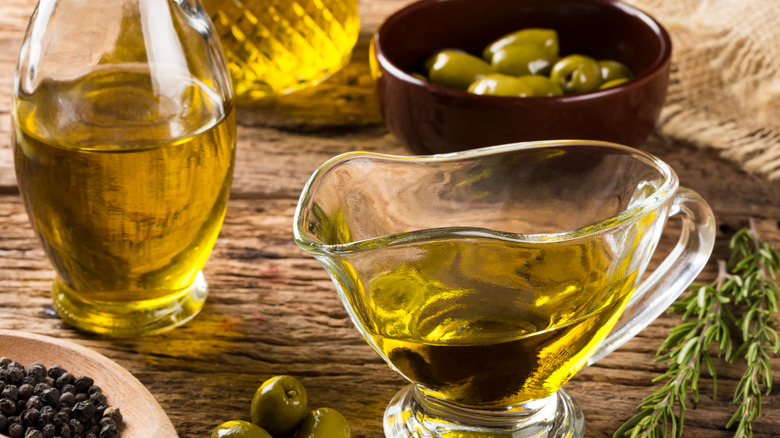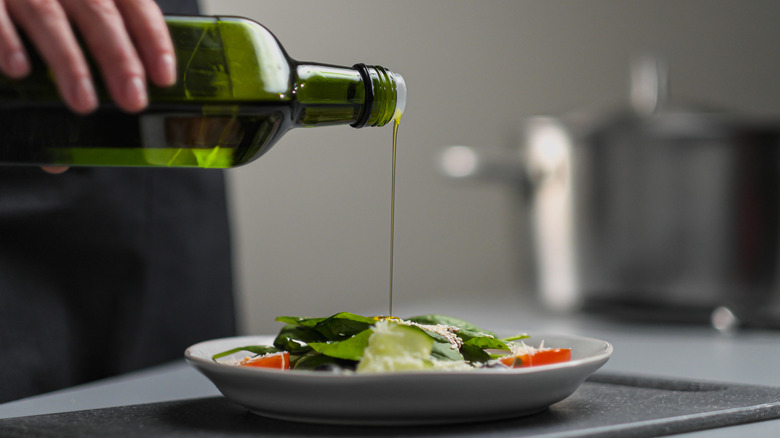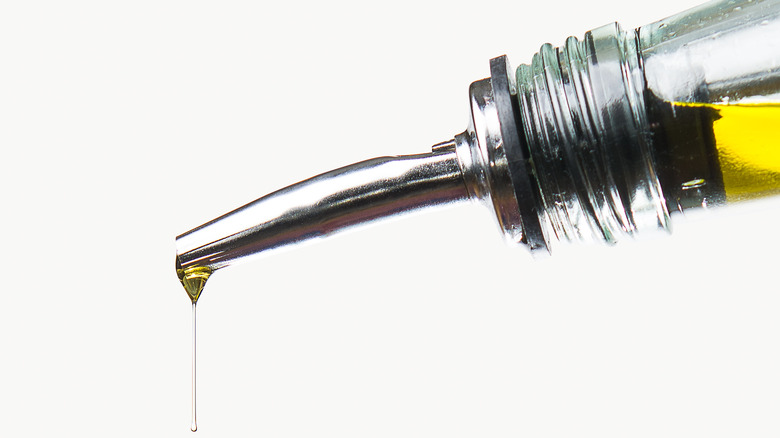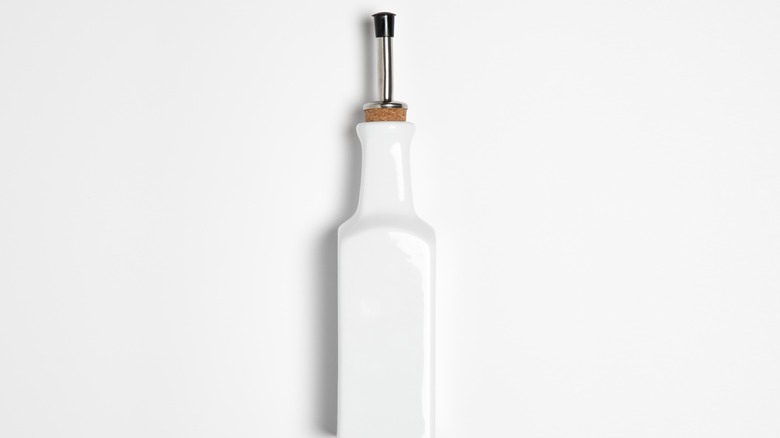The Importance Of Using A Good Olive Oil Pourer
For most avid cooks, olive oil is their best friend. Antioxidant-boasting olive oil adds flavor and fat to both cooked and raw dishes. Olive oil is heart healthy, has been known to decrease the risk of cancer and slow dementia, according to the North American Olive Oil Association, and is highly rated as skin moisturizer by JLo (per Well + Good. And when your best friend is in the kitchen, who wouldn't want to dress it up and let it stand out as the most favored of all ingredients? Enter olive oil's upgrade — the olive oil pourer.
Olive oil pourers, or cruets, are small decorative containers with pour spouts that claim to keep olive oil fresh and easy to pour. They certainly keep it within reach and look pretty 5on your countertop, but freshness is arguable, says Salvatore Russo-Tiesi, president and CEO of the olive oil brand Bono, in an interview with Martha Stewart. "As soon as the product hits light, heat, and air, it degrades quickly and significantly," he says. Transferring olive oil from its original container to another one exposes it to all three. It also can be extremely messy, and if you've ever tried to clean up spilt olive oil, you know it's an arduous task. Olivia Roszkowski, chef-instructor at the Institute of Culinary Education, shares with Martha Stewart that companies pack their oil in containers that will most likely maintain optimum freshness. Exposing it to light, air, and other elements immediately puts it at risk.
Olive oil pourers give you control
Despite the conflicting opinions on whether transferring olive oil to a separate pourer is a good idea or not, there are a few good reasons why it could be beneficial. For example, many people buy their olive oil in bulk. Using a cruet makes lifting and pouring easier. Cruets are pretty and make reaching for olive oil quick and easy as it sits out on your counter. If drizzling olive oil over salad, bread, or popcorn is a daily activity, an olive oil pourer will give you more control over drizzling and look attractive on your dining table. On the other hand, some companies, like Graza, sell olive oil in dark, light-inhibiting squeeze bottles so you can drizzle it everywhere with ease. Many other companies have adopted built-in dispensers that release a slow flow of oil instead of a heavy pour.
Either way, olive oil needs to be used, says Serious Eats. If having it sitting away in the back of your pantry discourages you from using it, by all means, get an olive oil pourer. And of course, it's really helpful if you lose or misplace the original lid to your olive oil bottle. If that's the case, there are two types of olive oil pourers you can purchase — the cruet and the pour spout.
Pour spouts can fit an original bottle
The pour spout is ideal, since you simply replace the original lid of your olive oil and don't have to transfer its contents into another container. North American Olive Oil Association explains that pour spouts should fit into most commercial olive oil bottles and keep air out of the oil. Pour spouts are usually not expensive and boast many different options. The publication recommends pour spouts with caps so that they can be sealed after use. Particularly they recommend spouts with caps that are attached that automatically close by a hinge when the bottle is upright. Serious Eats suggests that the best pour spouts have long metal spouts with a separate air intake for continuous pouring.
One thing to consider with a pour spout is the material it's made of. A spout with a cork stopper will seal tightly inside the opening (like a wine cork) but will need to be washed regularly and may eventually fall apart, reports Saveur. In contrast, a rubber stopper is more durable. Delicate materials like cork are not usually dishwasher safe and require hand cleaning, continues Serious Eats. Pour spouts don't fit every bottle, however, in which case you may want to consider a cruet.
Look for cruets that are heat and light resistant
A cruet is a beautiful option for your olive oil, and as Saveur puts it, allows you to "dispense more precisely." If your olive oil was packaged in a clear container, light filtration puts it at risk for oxidization. In Martha Stewart's interview with Salvatore Russo-Tiesi, he suggests wrapping the original container in tin foil. But an olive oil dispenser is more attractive and "key" to keeping oil fresh, suggests Epicurious. Look for a cruet that is made of ceramic or metal. These materials limit heat or light filtration. Cruets come with their own pour spouts, so look for ones that are easily washable with spouts featuring auto-close or a cap. Saveur suggests heat resistant, scratch resistant, and lightweight cruets with anti-drip and easy flow spouts. Also consider how the cruet fits in your hand and its size in relation to how often it will be used, continues Martha Stewart.
Washing and thoroughly drying your cruet is key to keeping your dispenser fresh. You don't want any old oil left in the bottle going rancid when you refill (via North American Olive Oil Association). Thoroughly rinse the dispenser with hot water, then hand wash with dish soap (or your dishwasher if your cruet is dishwasher safe), suggests Olive Knowledge. Next, rinse out with distilled white vinegar to remove any soapy residue, rinse again with water, and let it dry thoroughly. Olive oil is a sensitive ingredient. Pour generously, store with care.



